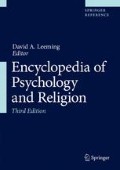Bibliography
Aksan, N., & Kochanska, G. (2004). Heterogeneity of joy in infancy. Infancy, 6(1), 79–94.
Campos, B., Shiota, M. N., Keltner, D., Gonzaga, G. C., & Goetz, J. L. (2013). What is shared, what is different? Core relational themes an expressive displays of eight positive emotions. Cognition & Emotion, 27(1), 37–52.
Ekman, P. (1999). Basic emotions. In T. Dalgleish & M. Power (Eds.), Handbook of cognition and emotion (pp. 45–60). Hoboken: Wiley.
Ghazi bin Muhammad, H. R. H. (2014). Joy in the Qur’an. Prepared for Yale Center for Faith & Culture consultation on “Religion of Joy,” August 21–22, 2014.
Keltner, D., Ekman, P., Gonzaga, G., & Beer, J. (2003). Facial expression of emotion. In R. Davidson, K. Scherer, & H. Goldsmith (Eds.), Handbook of affective sciences (pp. 415–432). London: Oxford University Press.
Klein, A. C. (2014). The four immeasurables: How to deepen equanimity, love, compassion, and joy. Tricycle. Online: https://tricycle.org/magazine/four-immeasurables/
Lewis, M., Alessandri, S. M., & Sullivan, M. W. (1990). Violation of expectancy, loss of control and anger expressions in young infants. Developmental Psychology, 26(5), 745–575.
May, R. (1981). Freedom and destiny. New York: W.W. Norton & Company.
Messinger, D. (2002). Positive and negative: Infant facial expressions and emotions. Current Directions in Psychological Science, 11, 1–6.
Moltmann, J. (2015). Christianity: A religion of joy. In M. Volf & J. E. Crisp (Eds.), Joy and human flourishing: Essays on theology, culture and the good life (pp. 1–16). Minneapolis: Fortress Press.
Robbins, B. D. (2006). An empirical, phenomenological study: Being joyful. In C. T. Fischer (Ed.), Qualitative research methods for psychologists: Introduction though empirical studies (pp. 173–211). Burlington: Academic.
Robbins, B. D. (2015). Building bridges between humanistic and positive psychology. In S. Joseph (Ed.), Positive psychology in practice: Promoting human flourishing in work, health, education, and everyday life (2nd ed., pp. 31–46). Hoboken: Wiley.
Robbins, B. D. (2016). The heart of humanistic psychology: Human dignity disclosed through a hermeneutic of love. Journal of Humanistic Psychology, 56(3), 223–237.
Robbins, B. D. (2018). The joyful life: A measure of unconditional happiness. Presented at the 2018 Conference of the Society for Humanistic Psychology Conference, March 2018.
Author information
Authors and Affiliations
Corresponding author
Editor information
Editors and Affiliations
Rights and permissions
Copyright information
© 2020 Springer Nature Switzerland AG
About this entry
Cite this entry
Robbins, B.D. (2020). Joy. In: Leeming, D.A. (eds) Encyclopedia of Psychology and Religion. Springer, Cham. https://doi.org/10.1007/978-3-030-24348-7_200076
Download citation
DOI: https://doi.org/10.1007/978-3-030-24348-7_200076
Published:
Publisher Name: Springer, Cham
Print ISBN: 978-3-030-24347-0
Online ISBN: 978-3-030-24348-7
eBook Packages: Behavioral Science and PsychologyReference Module Humanities and Social SciencesReference Module Business, Economics and Social Sciences

